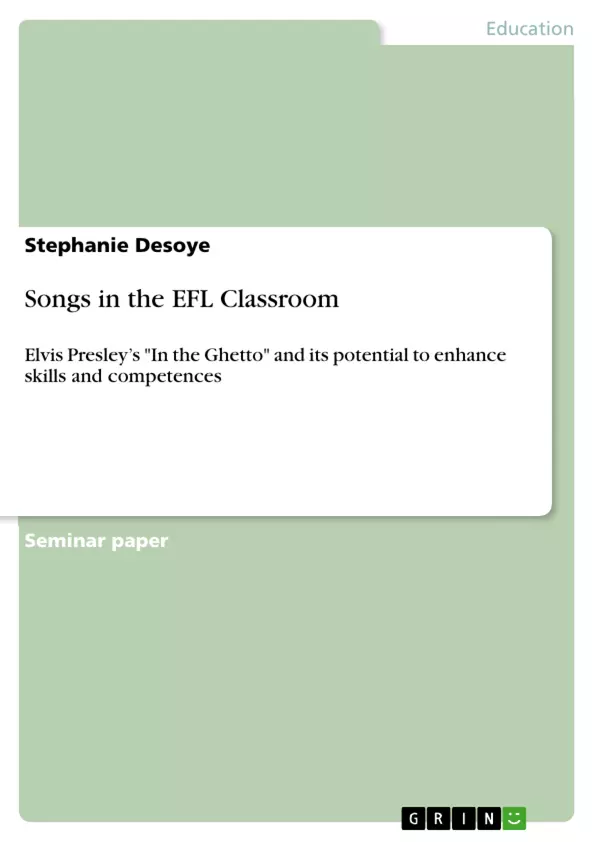The main purpose of this term paper will be to discuss the positive and problematic aspects of songs for the EFL classroom, as well as to analyze the value of Elvis Presley’s “In the Ghetto” for the classroom, including the presentation of a lesson plan.
The first part will focus on theoretical aspects, including a definition and classification of songs, as well as their advantages and problems for the English classroom. The second part will turn to the practical example of the song “In the Ghetto” by Elvis Presley. In a first step the song itself will be evaluated, considering its chances for the classroom, as well as investigating its problematic elements. In a next step a lesson plan with a focus on expanding knowledge and enhancing skills and competences will be presented and analyzed.
Songs are part of the daily life of most people—including teachers and especially pupils—which helps to connect school life with the student’s free time. Even though songs are an effective and useful teaching tool in itself, English benefits even more from songs due to the fact that English is the dominant language of the music industry. However, songs are still not used very often in the EFL classroom and many of the main textbooks used in Germany only include parts of songs or offer songs as extra activities (e.g. Green Line 5+6). One of the main reasons for this might be the difficulty of choosing an appropriate song for the classroom since songs sometimes include problematic elements.
Inhaltsverzeichnis (Table of Contents)
- 1. Introduction
- 2. Theoretical Part
- 2.1. Definition and Types of Songs
- 2.2. Advantages of Songs for the EFL Classroom
- 2.3. Problematic Aspects of Songs for the EFL Classroom
- 3. Practical Part
- 3.1. Analysis and Evaluation of the potential of a song for the EFL classroom: “In the Ghetto”-Elvis Presley
- 3.2. Presentation and Analysis of a Lesson Plan: Elvis Presley “In the Ghetto”—The Vicious Circle of Poverty
- 4. Conclusion
Zielsetzung und Themenschwerpunkte (Objectives and Key Themes)
This term paper aims to explore the advantages and disadvantages of using songs in the EFL classroom, specifically focusing on the analysis of Elvis Presley's "In the Ghetto" and its potential for educational purposes. The paper will provide a theoretical framework, including definitions, advantages, and limitations, and will present a detailed lesson plan designed to enhance learners' skills and competences.
- The effectiveness of songs as a teaching tool in the EFL classroom.
- The advantages and challenges of using songs for language, content, and skills development.
- The analysis of Elvis Presley's "In the Ghetto" for its suitability as classroom material.
- The development and presentation of a lesson plan focusing on "In the Ghetto" and its relevant themes.
- The potential of songs to connect classroom learning with learners' everyday lives.
Zusammenfassung der Kapitel (Chapter Summaries)
The introduction establishes the importance of songs in the EFL classroom, highlighting their relevance to students' lives and their potential for enhancing skills and competences. It outlines the structure of the paper, which focuses on theoretical aspects, practical analysis of "In the Ghetto," and a detailed lesson plan.
The theoretical part defines songs and explores their different categories, including pedagogical, traditional, and popular songs. It then delves into the advantages of using songs in the EFL classroom, highlighting their potential for enhancing language, content, and skills acquisition, as well as their ability to create a positive and stimulating learning environment.
Schlüsselwörter (Keywords)
The keywords for this paper include EFL classroom, songs, language acquisition, content development, skills enhancement, "In the Ghetto," Elvis Presley, lesson plan, cultural awareness, communicative competence, and motivation.
- Citation du texte
- Stephanie Desoye (Auteur), 2014, Songs in the EFL Classroom, Munich, GRIN Verlag, https://www.grin.com/document/1001001



